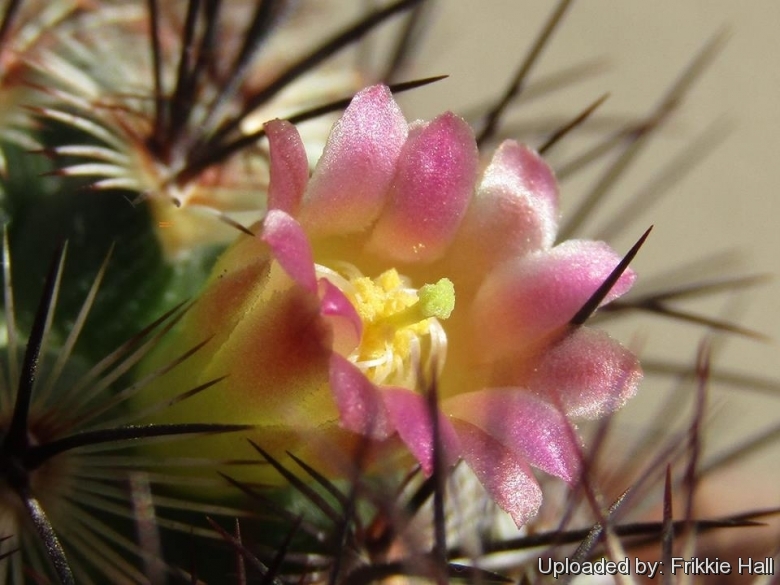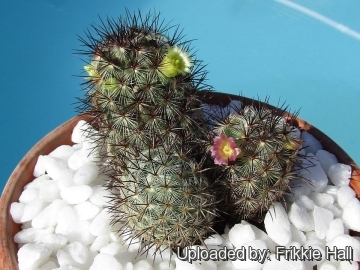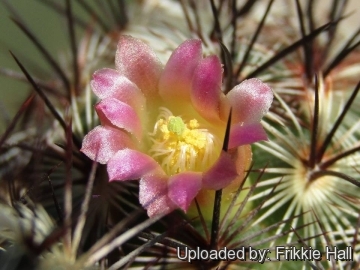= Mammillaria microhelia var. microheliopsis (Werderm.) Backeb.
Blätt. Kakteenf. 1937(2): [4] genus 131, sp. 8. as Mamillaria
Accepted Scientific Name: Mammillaria microhelia Werderm.
Monatsschr. Deutsch. Kakteen-Ges. 2: 236 1930

Mammillaria microheliopsis (Mammillaria microhelia var. microheliopsis) Photo by: Frikkie Hall
Origin and Habitat: Cultivated plants of unknown origin.
Synonyms:
See all synonyms of Mammillaria microhelia
back
Accepted name in llifle Database:Mammillaria microhelia Werderm.Monatsschr. Deutsch. Kakteen-Ges. 2: 236 1930Synonymy: 8
back
Description: Mammillaria microheliaSN|28215]]SN|28215]] Werdermann and Mammillaria microheliopsisSN|28217]]SN|28217]] Werdermann are very similar and it is hard to tell apart one from the other. More likely they are one and the same species. Today most authors have dismissed Mammillaria microheliopsisSN|28215]]SN|28217]] as perhaps not worthy of even varietal status, but it still has a value for a collector because they identify plants with particular characters. The key difference by which Mammillaria microheliopsisSN|28215]]SN|28217]] was separated, namely the more compact, usually almost spherical seedling (more cylindrical in M. microhelia), the smaller number of radial spines (30-40), and larger number of central spines (6 – 8), seems of no botanical value, representing no more than a local phenotype that appears to fall within the natural variation of Mammillaria microheliaSN|28217]]SN|28215]]. Moreover the exact place of origin of M. microheliopsis is not known and its specific name referers to the similarity with M. microhelia. The flowers, appearing in a ring near the top of the plant, are pink or purple (often pale yellowish or almost white in Mammillaria microheliaSN|28217]]SN|28215]]). The small tubercles are practically hidden by the numerous golden radial spines, but the central spines are a rich brown. Whatever Mammillaria microheliopsisSN|28217]]SN|28217]] is, it is an attractive cactus even when not in flower and the brown-and-gold spines give the plant a striking colour.
For more details see: Mammillaria microheliaSN|28215]]SN|28215]]
Subspecies, varieties, forms and cultivars of plants belonging to the Mammillaria microhelia group
 Mammillaria microhelia Werderm.: has a columnar stems. Flowers creamy-white, pink or purplish. Radial spines 30-50 white to yellowish. Centrals 1-4, sometimes absent, occasionally as many as 8(-11) dark reddish brown. Distribution: Queretaro, Mexico.
Mammillaria microhelia Werderm.: has a columnar stems. Flowers creamy-white, pink or purplish. Radial spines 30-50 white to yellowish. Centrals 1-4, sometimes absent, occasionally as many as 8(-11) dark reddish brown. Distribution: Queretaro, Mexico. Mammillaria microhelia var. microheliopsis (Werderm.) Backeb.: stems almost spherical, radial spines 30-40, central spines 6-8, flowers mostly pink or purplish. Distribution: unknown (originally described from cultivated plants).
Mammillaria microhelia var. microheliopsis (Werderm.) Backeb.: stems almost spherical, radial spines 30-40, central spines 6-8, flowers mostly pink or purplish. Distribution: unknown (originally described from cultivated plants).
Bibliography: Major references and further lectures
1) Werdermann “Blühende Kakteen und andere sukkulente Pflanzen”, volume 4, J. Neumann, 1936/37
2) Mammillaria microheliopsis in: “Gardeners Chronicle & New Horticulturist” Haymarket Publishing, 1958
3) Mammillaria microheliopsis in: The Cactus Journal, Blandford Press for the Cactus and Succulent Society of Great Britain, 1967
 Mammillaria microhelia with lime flowers and Mammillaria microhelia v. microheliopsis with pink coloured flowers. (Mammillaria microhelia var. microheliopsis) Photo by: Frikkie Hall
Mammillaria microhelia with lime flowers and Mammillaria microhelia v. microheliopsis with pink coloured flowers. (Mammillaria microhelia var. microheliopsis) Photo by: Frikkie Hall Mammillaria microheliopsis (Mammillaria microhelia var. microheliopsis) Photo by: Frikkie Hall
Mammillaria microheliopsis (Mammillaria microhelia var. microheliopsis) Photo by: Frikkie HallCultivation and Propagation: In good conditions with careful application of water and excellent ventilation Mammillaria microheliaSN|28215]]SN|28215]] var. microheliopsis grows without difficulty.
Growing rate: It is a slow growing species that rewards the patient grower with a beautiful displays of flowers since from an early age.
Soil: Requires good drainage provided by a very permeable open cactus soil (With not less than 50% grit content). Reduce the use of peat or other humus sources in the potting mixture.
Repotting: Repot every 2-3 years. Use small sized pots.
Feeding: During the beautiful season enrich the soil using a fertilizer rich in potassium and phosphorous, but poor in nitrogen, because this chemical element doesn’t help the development of succulent plants, making them too soft and full of water.
Watering: Water should be carefully applied and only when the soil is dry to the touch, as this cliff-dwelling species is very prone to root rot. Allow soil to drain thoroughly before watering again. Additionally, water should not be applied from above, as the feathery spines will retain water and add to rotting problems, but in good conditions with excellent ventilation, in bright light, it usually grows without particular difficulty. Do not water in the winter.
Light: Outside full sun or afternoon shade, inside it needs bright light, and some direct sun. Direct sun encourages flowering and heavy spine production.
Hardiness: Protect from frost. But it's hardy to -5°C if kept dry. A winter rest that allows the plant to shrivel (perhaps losing up to 25% of its summer height) will encourage flowering and long time survival.
Pests & diseases: It may be attractive to a variety of insects, but plants in good condition should be nearly pest-free, particularly if they are grown in a mineral potting-mix, with good exposure and ventilation. Nonetheless, there are several pests to watch for:
- Red spiders: Red spiders may be effectively rubbed up by misting the vulnerable plants every day
- Mealy bugs: occasionally they develop aerial into the new growth among the wool with disfiguring results, but the worst types develop underground on the roots and are invisible except by their effects.
- Scales: Scales are rarely a problem.
- Rot: it is only a minor problem with cacti if the plants are watered and “aired” correctly. If they are not, fungicides won't help all that much.
Propagation: Direct sow after last frost or (rarely) cuttings. Seeds germinate in 7-14 days at 21-27° C in spring, remove gradually the glass cover as soon the plants will be well rooted (ca 1-2 weeks) and keep ventilated, no full sun for young plants!













